Following the announcement of an intended rejection of the proposed windfarm in North Lewis, an informal meeting took place on Saturday between 15 of the Comhairle's 31 councillors. A delegation was despatched to Edinburgh for talks with First Minister Alex Salmond. As I reported in an earlier post on this subject, the Comhairle was deeply concerned that a once-in-a-lifetime opportunity for the Western Isles' economy was being lost.
Mr Salmond is seen as the salvation of the Western Isles economy, bearing in mind his timely intervention in the planned golf course for the Balmedie estate in Aberdeenshire, which saved the day for that project. Whether he can salvage the Lewis Windfarm is less than clear. The major problem is formed by the Special Protected Areas, peatland in the centre of the island designated under EU law in 2000. Violation of this by the windfarm would expose the UK government to court action and a massive fine.
The Comhairle will also take its case to the EU, with the argument that the SPA designation were not intended to stop economic development. Of course they weren't. It is a case of embracing industries which do not interfere with the SPA, and it requires a bit more inventiveness than just the quick buck from a windfarm. And, let's face it, it's not much of a buck for the Islands, £6m per annum. Nice sum, but much more would be made by AMEC et al.
Monday 28 January 2008
Lewis Chessmen

It was suggested by the Western Isles MP that the famous Lewis Chessmen should be returned to this island. This was rejected by the UK culture minister, who referred to the idea as nonsensical, alongside with a gibe at the Scottish Government.
The Lewis Chessmen were discovered in the sands of Uig Bay in the 19th century. They had been carved by visiting Vikings some 850 years ago, and left there for safekeeping. The Chessmen, now reproduced on a larger scale (like the one shown above at Ardroil) are thought to have been brought over from Norway.
It is a pity this idea has foundered in a sea of party-political bickering. Although the figurines do not originate here, they have been here a long time and were found in Lewis. An idea might be to keep a handful of the Chessmen in Western Isles Museum, to acknowledge their final provenance. But I somehow don't think that will happen.
Friday 25 January 2008
Windfarm rejected?
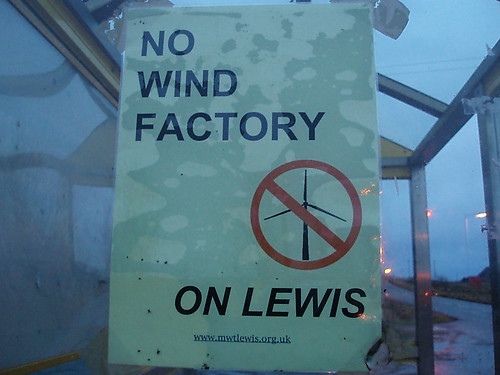
It was reported on Friday evening that the windfarm, proposed for the north of Lewis, is set to be rejected by Scottish Ministers. The project was for 181 turbines, each standing 450 feet tall, marching from Port of Ness in the north to Bragar in the west and Stornoway in the south. This would have meant one turbine for every 400 yards.
The windfarm was approved by the Western Isles Council, who had hailed the proposal as the salvation for the local economy. WIC convener Alec MacDonald expressed his deep disappointment at the likely rejection. Saliently, the Isles MSP [Member of Scottish Parliament], Alasdair Allan, was happy at the turning-down of the windfarm, saying it was too big for Lewis.
The main reason for Scottish Ministers not to approve the windfarm would seem to be environmental considerations. The islands are peppered with environmental designations, and the bird charity RSPB was most vocal in its opposition. Granting approval would have exposed the UK government (note!) to legal action from the EU, as the scheme is in violation of various environmental directives.
A final decision is likely within the next few weeks, as the developer (Lewis Windpower, LWP) has been given three weeks to come up with a reason why the project should go ahead after all, in the face of the opposition put forward by the Scottish Government.
If the decision is confirmed as a rejection, this puts the other two projects (in Eishken and Pairc) in doubt as well, to my mind. The reason is the Interconnector, the link-up with the electricity grid on the mainland across the Minch. It is not at all certain that the 50-odd turbines on the Eishken Estate and the 26 in Pairc would justify a £1bn cable across the water.
All shall be concluded by the middle of February.
Saturday 19 January 2008
HMS Rawalpindi
In recent times, I have been researching the Roll of Honour for World War II. That involves several sessions in Stornoway Library to peruse the various publications for:
Stornoway
North Lochs
South Lochs
Ness to Bernera
North Tolsta
Gress to Upper Coll
as well as an on-line Roll of Honour for Uig on the Hebridean Connections website. The village of Tong appears to have fallen by the wayside in this respect. Like with the Faces from the War Memorial project (World War I), I have listed those that lost their lives in the years between 1939 and 1945, or in later years if as a result of war service. The result can be seen here.
One of the most remarkable stories (and there are quite a few to be found) surrounds HMS Rawalpindi.

Image courtesy uboat.net
Rawalpindi was an Armed Merchant Cruiser, converted from a passenger liner by adding 10 pieces of gunnery. While patrolling north of the Faroe Islands on November 23, 1939, she investigated a possible enemy sighting, only to find that she had encountered two of the most powerful German warships, the battlecruisers Scharnhorst and Gneisenau trying to break out into the Atlantic. The Rawalpindi was able to signal the German ships' location back to base. Despite being hopelessly outgunned, Captain EC Kennedy of the Rawalpindi decided to fight, rather than surrender as demanded by the Germans. The German warships returned fire and sank Rawalpindi within forty minutes. Two hundred and thirty eight men died, including Captain Kennedy. Thirty seven men were rescued by the German ships and a further 11 were picked up by HMS Chitral (another converted passenger ship). Captain Kennedy, the father of broadcaster and author Ludovic Kennedy, was posthumously Mentioned in Dispatches. A detailed account, from the perspective of the Scharnhorst, can be read here.
Prime Minister Neville Chamberlain spoke in the House of Commons afterwards: "These men might have known, as soon as they sighted the enemy, that there was no chance, but they had no thought of surrender. They fired their guns until they could be fired no more, and many went to their deaths in the great tradition of the Royal Navy. Their example will be an inspiration to thosse that come after them".
In spite of these fine words, and in spite of later German reports, captain Kennedy was 'merely' [not my words] mentioned in despatches, and the crew have not been posthumously rewarded for their bravery.
This entry is dedicated to the 238 that lost their lives that day, and to the bravery of all 276 crew. Eight of the dead came from Lewis.
Stornoway
North Lochs
South Lochs
Ness to Bernera
North Tolsta
Gress to Upper Coll
as well as an on-line Roll of Honour for Uig on the Hebridean Connections website. The village of Tong appears to have fallen by the wayside in this respect. Like with the Faces from the War Memorial project (World War I), I have listed those that lost their lives in the years between 1939 and 1945, or in later years if as a result of war service. The result can be seen here.
One of the most remarkable stories (and there are quite a few to be found) surrounds HMS Rawalpindi.

Image courtesy uboat.net
Rawalpindi was an Armed Merchant Cruiser, converted from a passenger liner by adding 10 pieces of gunnery. While patrolling north of the Faroe Islands on November 23, 1939, she investigated a possible enemy sighting, only to find that she had encountered two of the most powerful German warships, the battlecruisers Scharnhorst and Gneisenau trying to break out into the Atlantic. The Rawalpindi was able to signal the German ships' location back to base. Despite being hopelessly outgunned, Captain EC Kennedy of the Rawalpindi decided to fight, rather than surrender as demanded by the Germans. The German warships returned fire and sank Rawalpindi within forty minutes. Two hundred and thirty eight men died, including Captain Kennedy. Thirty seven men were rescued by the German ships and a further 11 were picked up by HMS Chitral (another converted passenger ship). Captain Kennedy, the father of broadcaster and author Ludovic Kennedy, was posthumously Mentioned in Dispatches. A detailed account, from the perspective of the Scharnhorst, can be read here.
Prime Minister Neville Chamberlain spoke in the House of Commons afterwards: "These men might have known, as soon as they sighted the enemy, that there was no chance, but they had no thought of surrender. They fired their guns until they could be fired no more, and many went to their deaths in the great tradition of the Royal Navy. Their example will be an inspiration to thosse that come after them".
In spite of these fine words, and in spite of later German reports, captain Kennedy was 'merely' [not my words] mentioned in despatches, and the crew have not been posthumously rewarded for their bravery.
This entry is dedicated to the 238 that lost their lives that day, and to the bravery of all 276 crew. Eight of the dead came from Lewis.
Friday 18 January 2008
Month of Decisions
Here we are then, in the second half of January, in eager anticipation of a couple of decisions which could seriously alter life in Lewis as we know it.
Before the end of January, the Scottish Government will decide whether it will approve the planning application for the North Lewis Windfarm.
Before the end of January, Caledonian MacBrayne will decide whether to sail from Stornoway to Ullapool on a Sunday.
I have pontificated at length on either issue, so am just listing them here.
Although Uist is outside my remit, I am just amazed at the formidable mess that has been made of the suggested move of the mainland terminus for ferry services from the Southern Isles. There is some wrangling going on, as convoluted as it is unnecessary. I would think that shaving 3 hours off a 6 or 7 hour ferry crossing would be welcome, whether you're in Barra or the Uists...
Better close with some images of Ness, which I took this afternoon as I was out photographing another war memorial.
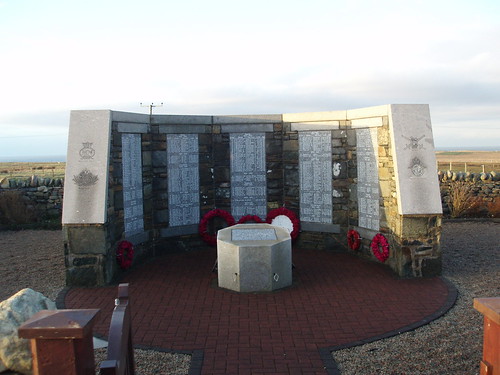
Ness War Memorial, Cross
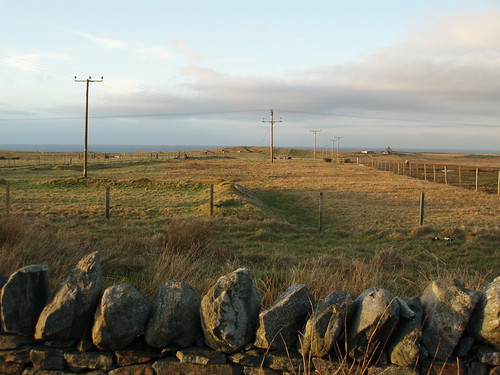
View behind the War Memorial

Low sun over houses at Cross
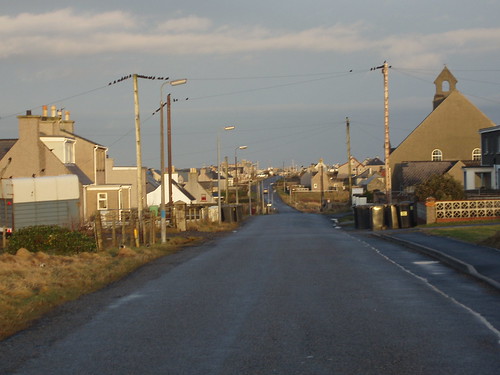
The road through Cross
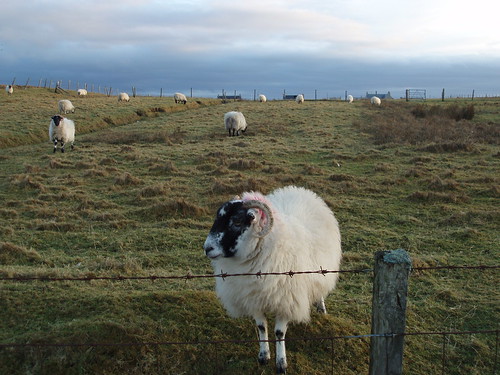
Sheep in croft between Cross and Swainbost
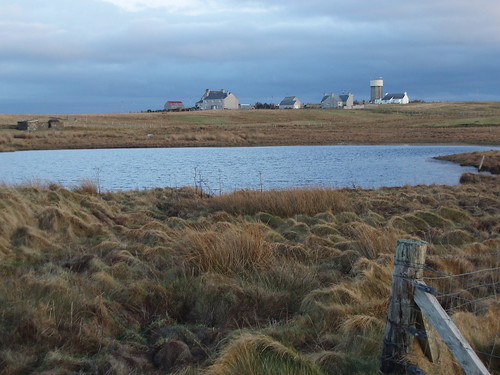
Loch between Cross and Swainbost
Before the end of January, the Scottish Government will decide whether it will approve the planning application for the North Lewis Windfarm.
Before the end of January, Caledonian MacBrayne will decide whether to sail from Stornoway to Ullapool on a Sunday.
I have pontificated at length on either issue, so am just listing them here.
Although Uist is outside my remit, I am just amazed at the formidable mess that has been made of the suggested move of the mainland terminus for ferry services from the Southern Isles. There is some wrangling going on, as convoluted as it is unnecessary. I would think that shaving 3 hours off a 6 or 7 hour ferry crossing would be welcome, whether you're in Barra or the Uists...
Better close with some images of Ness, which I took this afternoon as I was out photographing another war memorial.

Ness War Memorial, Cross

View behind the War Memorial

Low sun over houses at Cross

The road through Cross

Sheep in croft between Cross and Swainbost

Loch between Cross and Swainbost
Saturday 12 January 2008
Visit to Callanish with a difference
As part of my activities related to local history (World Wars I and II), I am currently visiting some of the War Memorials across Lewis. Went to Callanish on Friday to photograph the new memorial, which was erected in the carpark of the Free Church in 2005/6. It lists casualties from Breasclete, Callanish and Garynahine, all communities along the shores of East Loch Roag.
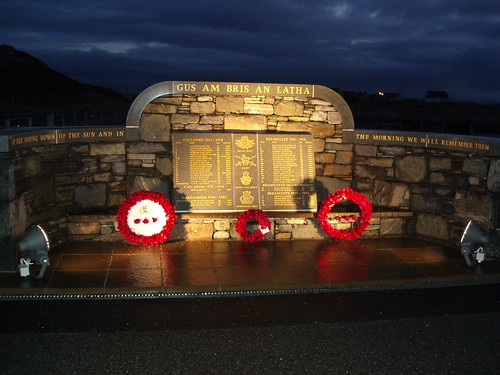
The line at the top of the memorial reads "Gus am Bris an Latha" [Until the Breaking of the Day], which is a common expression on gravestones in the island. For reference, it points to the religious belief that the Dead will rise on the Youngest Day, the Day of Judgment. The line below is quoted from a poem, commonly recited around Remembrance Day in November: At the going down of the sun and in the morning - we will remember them.
I have a special request - if anyone in the Uists has a photo on-line of the memorial at Clachan ath Luib in North Uist, I would greatly appreciate the leaving of a link. This is solely for use on an internet bulletin board related to War Memorials in Scotland, and will be posted with proper attribution.
As the photo shows, I attended the memorial at dusk, and having taken the pictures I needed, I walked the one mile to the Callanish Stones. Light failed as I covered the distance, leading to some special imagery.
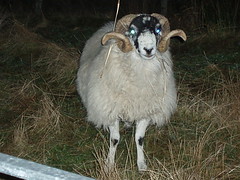

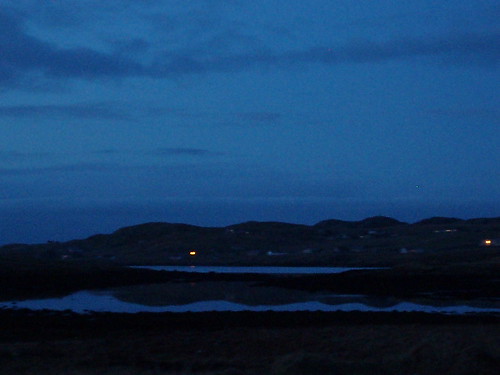

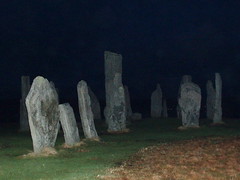

The line at the top of the memorial reads "Gus am Bris an Latha" [Until the Breaking of the Day], which is a common expression on gravestones in the island. For reference, it points to the religious belief that the Dead will rise on the Youngest Day, the Day of Judgment. The line below is quoted from a poem, commonly recited around Remembrance Day in November: At the going down of the sun and in the morning - we will remember them.
I have a special request - if anyone in the Uists has a photo on-line of the memorial at Clachan ath Luib in North Uist, I would greatly appreciate the leaving of a link. This is solely for use on an internet bulletin board related to War Memorials in Scotland, and will be posted with proper attribution.
As the photo shows, I attended the memorial at dusk, and having taken the pictures I needed, I walked the one mile to the Callanish Stones. Light failed as I covered the distance, leading to some special imagery.





North Lewis Windfarm
Mr Mather, the Minister for Energy (and many other things) has announced that a decision on the North Lewis Windfarm will be taken before the end of January 2008. Speaking to Leslie Riddoch on Radio Scotland on Friday, he would not be drawn which way the decision was likely to go. He did make it clear that a local referendum, as proposed by our MSP, is not on the cards.
On Friday morning, Mr Allan was quoted as saying that a local referendum, organised by local people outwith the Comhairle and the Scottish Government, would be another consideration for the Scottish Government in reaching a decision. Mr Mather's pronouncement appears to scuttle that idea.
Reading various local publications, nobody appears to be certain what the likely decision will be. It is a pity that a formal referendum will not be held, but unofficial polls over the past 3 years have indicated a broad level of opposition (varying from 50 to 90% of people in the island).
Taking into consideration the Scottish Government declared opposition to more nuclear powerstations on Scottish soil, and its headlong rush into windpower (both onshore and offshore) would appear to indicate a slant towards approving the North Lewis project. Other technologies (wave and tidal power) are not sufficiently developed to making a material contribution to Scotland's (the UK's? Europe's?) energy needs. Offshore windpower appears to be problematic though, because the seas around Scotland are too deep to house turbines. The Scottish Government is also shown to be amenable towards the wishes of big business, e.g. Donald Trump. The AMEC project is worth £500m.
My position is on record on this blog, as opposed. In summary: destruction of visual amenity, a fragile eco-system, a bird sanctuary and part of island life and history. Overstating of the job potential and a derisory financial contribution to the island economy, when compared to the hundreds of millions that stand to be made by AMEC et al.
It is now in the hands of Scottish Ministers and I await the decision with interest.
On Friday morning, Mr Allan was quoted as saying that a local referendum, organised by local people outwith the Comhairle and the Scottish Government, would be another consideration for the Scottish Government in reaching a decision. Mr Mather's pronouncement appears to scuttle that idea.
Reading various local publications, nobody appears to be certain what the likely decision will be. It is a pity that a formal referendum will not be held, but unofficial polls over the past 3 years have indicated a broad level of opposition (varying from 50 to 90% of people in the island).
Taking into consideration the Scottish Government declared opposition to more nuclear powerstations on Scottish soil, and its headlong rush into windpower (both onshore and offshore) would appear to indicate a slant towards approving the North Lewis project. Other technologies (wave and tidal power) are not sufficiently developed to making a material contribution to Scotland's (the UK's? Europe's?) energy needs. Offshore windpower appears to be problematic though, because the seas around Scotland are too deep to house turbines. The Scottish Government is also shown to be amenable towards the wishes of big business, e.g. Donald Trump. The AMEC project is worth £500m.
My position is on record on this blog, as opposed. In summary: destruction of visual amenity, a fragile eco-system, a bird sanctuary and part of island life and history. Overstating of the job potential and a derisory financial contribution to the island economy, when compared to the hundreds of millions that stand to be made by AMEC et al.
It is now in the hands of Scottish Ministers and I await the decision with interest.
Thursday 10 January 2008
The Hurricane - 3 years on
By the time this post gets published, it will be Friday 11 January 2008. Going back three years, we were about to experience the worst storms in 50 years. At 3pm, exactly as forecast, the wind whipped up to hurricane force. Powerlines went down all over the island, leaving people without electricity for anything between a few hours and up to 6 days. Property damage was widespread and severe.
Staying in South Lochs at the time, I lost power at 6.20 that evening, not to get it back for 48 hours. From the darkness, I could see blue flashing lights across Loch Erisort. Later, it became clear that this was the police, closing the A859 Stornoway to Tarbert road. A lorry driver had reported as sheep flying past his windscreen. The driver on the last bus into South Lochs had a terrifying time keeping his vehicle on the straight and narrow.
By 6pm, people in Stornoway were physically blown off their feet. Some sustained injuries as a result. Trees in the Castle Grounds were falling like match sticks, boats were ripped off their moorings and tossed onto the harbour wall at the Newton Basin. Flooding affected the town centre.
Down in the Southern Isles, a family of five found their home in Iochdar, South Uist, being pounded by pebbles and flying spray from the nearby sea. A flurry of phonecalls arranged a move across the causeway into Benbecula. Two cars would carry the grandfather, two parents and two young children across the few miles.
Dawn broke at 9 o'clock. The islanders, from Barra to Lewis, were mentioning that it had been a particularly nasty one, and people were comparing notes what damage everyone had sustained. A phonecall disturbed the sense of relief. People were reported missing in South Uist. A search party started combing the South Ford, which separates Benbecula from South Uist. The bodies of five people were found in the course of the next few days. They were those of a grandfather, two parents and their young children. Please view this page on the BBC News website for details. I cannot print their portraits here.
The funeral service, a few days later, was attended by 1,500 people, one out of every three islanders in the Southern Isles. Only 500 could actually enter the church, the rest followed the service outside, as it was relayed through loudspeakers.
Total damage was estimated to be worth £15 million, including severe storm damage to the causeway system stretching from Berneray to Eriskay. Repairs are only now being carried out.
This post is dedicated to the memory of those lost in the Iochdar tragedy.
Staying in South Lochs at the time, I lost power at 6.20 that evening, not to get it back for 48 hours. From the darkness, I could see blue flashing lights across Loch Erisort. Later, it became clear that this was the police, closing the A859 Stornoway to Tarbert road. A lorry driver had reported as sheep flying past his windscreen. The driver on the last bus into South Lochs had a terrifying time keeping his vehicle on the straight and narrow.
By 6pm, people in Stornoway were physically blown off their feet. Some sustained injuries as a result. Trees in the Castle Grounds were falling like match sticks, boats were ripped off their moorings and tossed onto the harbour wall at the Newton Basin. Flooding affected the town centre.
Down in the Southern Isles, a family of five found their home in Iochdar, South Uist, being pounded by pebbles and flying spray from the nearby sea. A flurry of phonecalls arranged a move across the causeway into Benbecula. Two cars would carry the grandfather, two parents and two young children across the few miles.
Dawn broke at 9 o'clock. The islanders, from Barra to Lewis, were mentioning that it had been a particularly nasty one, and people were comparing notes what damage everyone had sustained. A phonecall disturbed the sense of relief. People were reported missing in South Uist. A search party started combing the South Ford, which separates Benbecula from South Uist. The bodies of five people were found in the course of the next few days. They were those of a grandfather, two parents and their young children. Please view this page on the BBC News website for details. I cannot print their portraits here.
The funeral service, a few days later, was attended by 1,500 people, one out of every three islanders in the Southern Isles. Only 500 could actually enter the church, the rest followed the service outside, as it was relayed through loudspeakers.
Total damage was estimated to be worth £15 million, including severe storm damage to the causeway system stretching from Berneray to Eriskay. Repairs are only now being carried out.
This post is dedicated to the memory of those lost in the Iochdar tragedy.
Wednesday 9 January 2008
South Lochs
Went for a quick visit to Kershader, South Lochs, yesterday. Very cold, there was ice in the road verges and on the lochs. As I arrived at 3pm, within an hour of sunset, light was at a premium. Still, I'd like to think I captured the mood and beauty of the place. I only know it in a wintry setting, as I spent the winter of 2004/5 in this area.
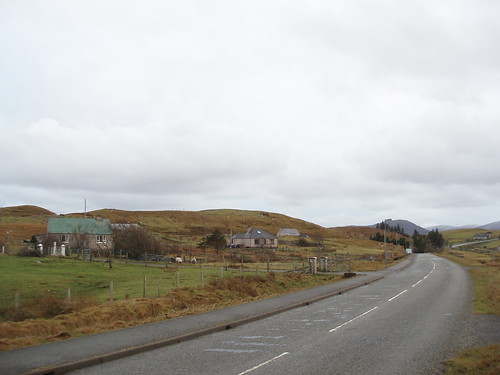
Kershader village
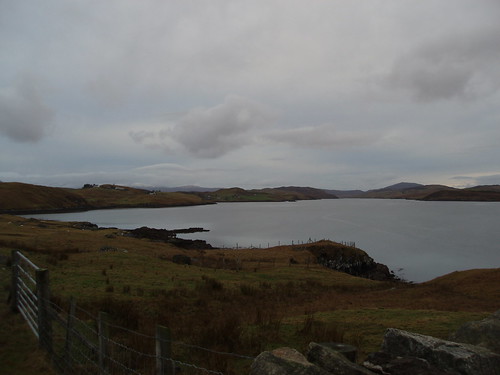
Loch Erisort at Kershader

Loch Erisort from a peatroad east of Kershader
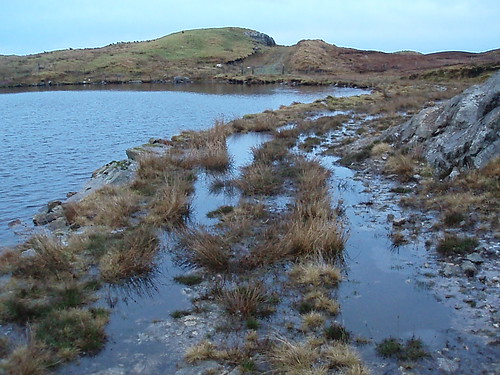
Waterlogged track along Loch an Tairbeirt
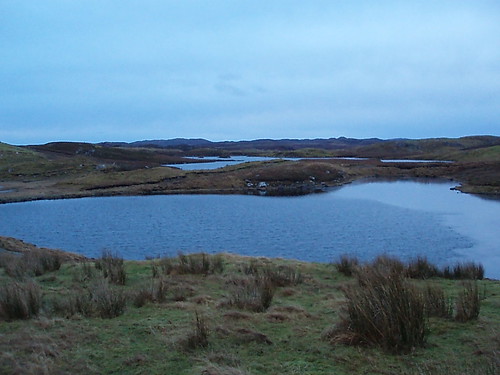
A clue to the answer to "why is this area called Lochs?"
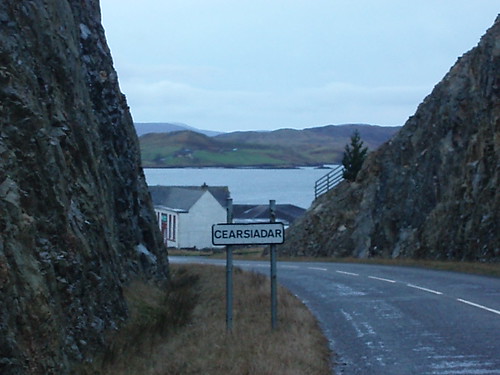
Returning to the village

Balallan at dusk

Kershader village

Loch Erisort at Kershader

Loch Erisort from a peatroad east of Kershader

Waterlogged track along Loch an Tairbeirt

A clue to the answer to "why is this area called Lochs?"

Returning to the village

Balallan at dusk
Thursday 3 January 2008
Happy New Year

Best wishes for 2008 from Stornoway, on a beautifully sunny but cold Thursday morning. The cans and bottles of Christmas and New Year were taken away in the recycling lorry yesterday morning, and the last vestiges of the festive season will be taken down on the Epiphany, on Sunday (January 6).
Wonder what 2008 will bring to the Heather Isle. A decision on the North Lewis and Eishken and Pairc windfarms? Fat chance. Although a decision is being sought urgently off the administration in Holyrood, they are juggling this hot potato. They are also juggling the hot potato called the Mallaig to Lochboisdale ferry service, after conveniently forgetting that a cheap option was available. Better not say why that was, might get me in * hot * water. Arnish Lighthouse in hot water? Never...
The Arnish Fabrication Yard appears to be in slightly calmer waters with a big order from Turkey. Pity it has to be rushed through in 12 months, rather than 18 months. I'll watch out for a throng of diaspora on board the MV Isle of Lewis and coming five abreast down the Arnish Road to work on the turbines.
Talking of our good old ferry boat, will we see it running on Sunday? I'd almost say, yes, but again, it's a hot potato, so more juggling for the Holyrood administration.
Happy New Year!
Subscribe to:
Posts (Atom)